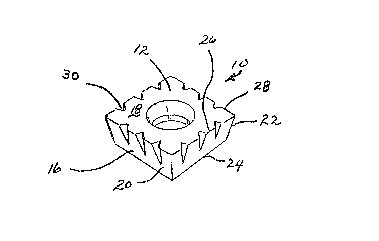Some of the information on this Web page has been provided by external sources. The Government of Canada is not responsible for the accuracy, reliability or currency of the information supplied by external sources. Users wishing to rely upon this information should consult directly with the source of the information. Content provided by external sources is not subject to official languages, privacy and accessibility requirements.
Any discrepancies in the text and image of the Claims and Abstract are due to differing posting times. Text of the Claims and Abstract are posted:
| (12) Patent: | (11) CA 2100632 |
|---|---|
| (54) English Title: | POSITIVE RAKE INSERT HAVING SERRATIONS FOR CUTTING |
| (54) French Title: | PLAQUETTE D'USINAGE RAPPORTEE A PENTE POSITIVE ET STRIES |
| Status: | Expired and beyond the Period of Reversal |
| (51) International Patent Classification (IPC): |
|
|---|---|
| (72) Inventors : |
|
| (73) Owners : |
|
| (71) Applicants : |
|
| (74) Agent: | R. WILLIAM WRAY & ASSOCIATES |
| (74) Associate agent: | |
| (45) Issued: | 1998-07-07 |
| (22) Filed Date: | 1993-07-15 |
| (41) Open to Public Inspection: | 1994-02-04 |
| Examination requested: | 1996-03-20 |
| Availability of licence: | N/A |
| Dedicated to the Public: | N/A |
| (25) Language of filing: | English |
| Patent Cooperation Treaty (PCT): | No |
|---|
| (30) Application Priority Data: | ||||||
|---|---|---|---|---|---|---|
|
A polygonal, indexable cutting insert having a positive rake
and a cutting edge having a truncated sinusoidal form.
La présente invention vise une pastille de découpage indexable polygonale présentant un angle de coupe positif et un tranchant de forme sinusoïdale tronquée.
Note: Claims are shown in the official language in which they were submitted.
Note: Descriptions are shown in the official language in which they were submitted.

2024-08-01:As part of the Next Generation Patents (NGP) transition, the Canadian Patents Database (CPD) now contains a more detailed Event History, which replicates the Event Log of our new back-office solution.
Please note that "Inactive:" events refers to events no longer in use in our new back-office solution.
For a clearer understanding of the status of the application/patent presented on this page, the site Disclaimer , as well as the definitions for Patent , Event History , Maintenance Fee and Payment History should be consulted.
| Description | Date |
|---|---|
| Time Limit for Reversal Expired | 2006-07-17 |
| Inactive: IPC from MCD | 2006-03-11 |
| Letter Sent | 2005-07-15 |
| Grant by Issuance | 1998-07-07 |
| Pre-grant | 1998-03-23 |
| Inactive: Final fee received | 1998-03-23 |
| Notice of Allowance is Issued | 1997-10-21 |
| Letter Sent | 1997-10-21 |
| Notice of Allowance is Issued | 1997-10-21 |
| Inactive: Status info is complete as of Log entry date | 1997-10-15 |
| Inactive: Application prosecuted on TS as of Log entry date | 1997-10-15 |
| Inactive: Approved for allowance (AFA) | 1997-08-12 |
| Classification Modified | 1997-08-12 |
| Inactive: IPC removed | 1997-08-12 |
| Inactive: First IPC assigned | 1997-08-12 |
| Inactive: IPC assigned | 1997-08-12 |
| All Requirements for Examination Determined Compliant | 1996-03-20 |
| Request for Examination Requirements Determined Compliant | 1996-03-20 |
| Application Published (Open to Public Inspection) | 1994-02-04 |
There is no abandonment history.
The last payment was received on 1997-06-30
Note : If the full payment has not been received on or before the date indicated, a further fee may be required which may be one of the following
Patent fees are adjusted on the 1st of January every year. The amounts above are the current amounts if received by December 31 of the current year.
Please refer to the CIPO
Patent Fees
web page to see all current fee amounts.
| Fee Type | Anniversary Year | Due Date | Paid Date |
|---|---|---|---|
| MF (application, 4th anniv.) - standard | 04 | 1997-07-15 | 1997-06-30 |
| Final fee - standard | 1998-03-23 | ||
| MF (patent, 5th anniv.) - standard | 1998-07-15 | 1998-07-13 | |
| MF (patent, 6th anniv.) - standard | 1999-07-15 | 1999-06-18 | |
| MF (patent, 7th anniv.) - standard | 2000-07-17 | 2000-06-21 | |
| MF (patent, 8th anniv.) - standard | 2001-07-16 | 2001-06-20 | |
| MF (patent, 9th anniv.) - standard | 2002-07-15 | 2002-06-20 | |
| MF (patent, 10th anniv.) - standard | 2003-07-15 | 2003-07-08 | |
| MF (patent, 11th anniv.) - standard | 2004-07-15 | 2004-06-25 |
Note: Records showing the ownership history in alphabetical order.
| Current Owners on Record |
|---|
| VALENITE INC. |
| Past Owners on Record |
|---|
| PAUL ALLAIRE |